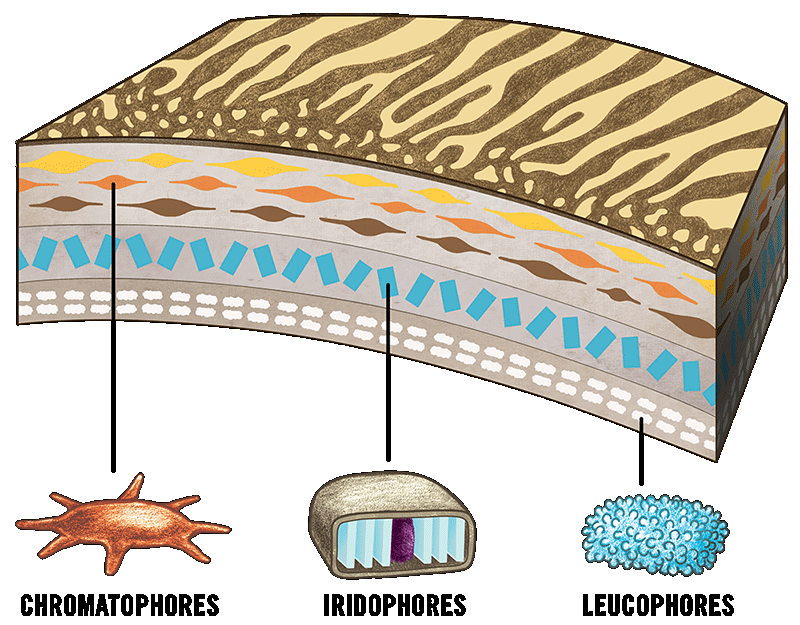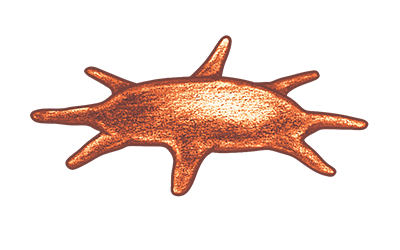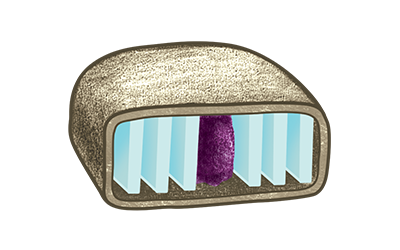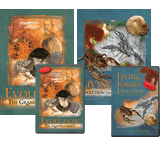Masters of Disguise
Cuttlefish are the world’s greatest disappearing artists. With lightning speed, they can change their color and shape to match their surroundings.
A spider crab scurries along the sandy seafloor, watching for predators, but it sees nothing except the gentle rolls of tan-colored sand. Suddenly, a sand-colored monster rises from the seafloor, two tentacles stabbing forward, and it’s all over.
Farther down the reef, a tiny bass lazily feeds among the swaying kelp forest, certain that the thick brownish-green fronds will keep it safe from attack. Without warning, one of the fronds lashes out with two tentacles, and it’s all over.
A wary clownfish darts among the coral, looking for food and avoiding any sign of danger. Abruptly the mottled white-and-grey coral transforms into a ten-armed, squidlike creature. Two tentacles shoot out, and it’s all over.
Every day, the world’s master of disguise, the cuttlefish, finds new ways to blend into its ever-changing surroundings in search of its next meal. Cuttlefish are so good at imitation that they can instantly transform into a black-and-white chessboard or any other surrounding that mischievous researchers can think of.

Fotosearch | Getty Images
The bright patterns and colors of the cuttlefish might make you think these creatures are easy prey, but God designed them with a great ability.

Fotosearch | Getty Images
The bright patterns and colors of the cuttlefish might make you think these creatures are easy prey, but God designed them with a great ability.
A Gift from God?
If God created a perfect world, then why do so many animals have the gift of camouflage? This question has perplexed many a creationist. The argument is easy to follow—animals like the cuttlefish use specialized colorings and shapes to hide from prey or predators. But before the Fall animals didn’t eat other animals. So why would God purposefully design animals with the ability to hide from each other?
Just because an animal can use its abilities to hide artfully does not mean that it can’t use those skills for other purposes. For example, the chameleon, the go-to camouflage creature, can change its shade to nearly any color of the rainbow, including ones it would never encounter in nature. Why? One reason is that it’s beautiful. God loves beautiful things—look for yourself. But another reason is that chameleons use color to communicate with each other. This is a skill that has no bearing on predators whatsoever.
The world’s best chameleon is not found in the forests of Africa, however, but on the seafloor. Feast your eyes on the cuttlefish.
Cuttlefish Basics
Now, before we get into the unique, wondrous designs God gave these delightful little illusionists, let’s address the first question. What is a cuttlefish? It’s not a fish! Cuttlefish are marine mollusks, like slugs and snails. They belong to the same group as squid and octopods—cephalopods. So they share many of the same cool features as their eight- and ten-armed cousins.
They have a large body called a mantle, ending in multiple arms surrounding a beak-like mouth. On average they grow ten inches (25 cm) long, though the Australian giant cuttlefish reaches twice that size. Cuttlefish have ten arms, two of which have specially designed pads they use to capture prey. Dinner primarily consists of crab and fish, though they have been known to eat shrimp, mollusks, and other cuttlefish. They prefer shallow, tropical waters with plenty of food and places to hide.
Cuttlefish get their name from the bone in their mantle called, unsurprisingly, the cuttlebone. This is actually a shell that they wear on the inside. It is used to control buoyancy, like a fish’s swim bladder, collecting and releasing gas. The cuttlebone has several chambers to store both gas and water.
Though the cuttlebone is unique to cuttlefish, the thing that makes them seagoing superstars is their unparalleled camouflaging skill. Cuttlefish can dramatically alter the colors, patterns, and even texture of their skin. Several interconnected designs are necessary for this to occur, and only an ingenious Creator could put them all together. Between their sharp eyesight, color sacs, specialized muscle cells, and supersized brain, no other creature in the animal kingdom can change its appearance the way cuttlefish can—and all in the blink of an eye.

Irko Van Der Heide | Dreamstime.com
Patterns and shapes are difficult for even talented artists to copy, yet the cuttlefish does it easily because of its incredible God-given design.

Irko Van Der Heide | Dreamstime.com
Patterns and shapes are difficult for even talented artists to copy, yet the cuttlefish does it easily because of its incredible God-given design.
The Eyes Have It
To camouflage well, you have to see your surroundings in astounding detail. Cuttlefish depend heavily on their eyesight. They have two very large eyes, one on each side of their mantle. The distinct “w” shape of their pupil is thought to allow the cuttlefish to control the intensity of the light entering its eye. Living in shallow waters subjects their sensitive eyes to bright daylight that they must control to avoid blindness. They also need to see well in darkness, navigating and protecting themselves at night.
Cuttlefish can’t move their eyes around in their sockets, like people do. Instead, they reshape their entire eyeball to focus on the world around them.
But the most pertinent ability of the cuttlefish eye is its ability to detect polarized light. Polarized light refers to light waves that are moving in a single direction. For example, when sunlight bounces off the surface of the ocean floor, many of those light waves will move in the same direction, giving them a higher degree of polarization. By being able to detect these polarizations, cuttlefish can copy them accurately, so that fish looking up in their direction will think they are seeing sunlight trickling down through the water.
Colors for All Occasions
Along with excellent eyesight, God also provided cuttlefish with incredibly flexible pigments in their skin. Cuttlefish skin is specially layered with cells that they can stretch and move to make sudden and breathtaking changes in color. The outermost layer of skin, called the epidermis, is very thin and clear. This allows light to penetrate while still protecting the cuttlefish’s body. Beneath the epidermis are layers of specialized cells called chromatophores, iridophores, and leucophores.
The uppermost cells, the chromatophores, supply the most basic colors cuttlefish use. In hues of yellow, red, and brown, the chromatophores act as small packets of color that the cuttlefish can shrink or expand at will, allowing it to communicate, find a mate, hypnotize its prey, or hide from predators.
The iridophore cells are highly reflective and iridescent (the colors change depending on the angle, like on some butterfly wings). This gives the cuttlefish a metallic sheen of colors like pink, green, blue, and silver.
Leucophore cells are nearly perfect at scattering light uniformly. This allows the cuttlefish to display white colors across its skin. These cells also aid in passive camouflaging by reflecting the environment’s colors.

Asther Lau Choon Siew | Dreamstime.com
In addition to changing color, cuttlefish can change their texture to help blend seamlessly into the ocean floor.

Asther Lau Choon Siew | Dreamstime.com
In addition to changing color, cuttlefish can change their texture to help blend seamlessly into the ocean floor.
Give It a Little Texture
Flashing colors and shiny skin might be enough to satisfy some artists, but God gave cuttlefish an additional skill, literally adding depth to their displays. With naturally shiny skin and an easily recognized ten-arm silhouette, cuttlefish must go an extra step to hide themselves. Cuttlefish can dramatically alter the texture of their skin! It can look like sand, pebbles, or other objects. Naturally, their skin is smooth, but by changing its texture, cuttlefish can mold their bodies into the background to vanish entirely.
How do they shape-shift? Beneath the layers of cells that provide color are muscle cells that form little circles, or bands. When these cells contract, the fluid inside them is forced upward, covering the smooth skin with spikes, flat blades, or other shapes to match the surrounding terrain. Changes in texture happen as quickly as changes in color.

Jeremy Brown | Dreamstime.com
The Creator placed within the cuttlefish’s very cells the abilities to shift color, shape, and texture to match the surrounding rocks and coral.

Jeremy Brown | Dreamstime.com
The Creator placed within the cuttlefish’s very cells the abilities to shift color, shape, and texture to match the surrounding rocks and coral.
One Brain to Rule It All
Cuttlefish are smart, too. If they imitate kelp, for instance, they can control their bodies to look like waving fronds. All their interconnected systems are expertly manipulated within seconds. Controlling just one aspect would require significant brain power. Adding so many other layers of complexity compounds the problem exponentially. But God knew what He was doing when He created cuttlefish. He provided them with one of the largest brain-to-body size ratios of any invertebrate, even when compared to octopods, the reigning champions of clever.
Faster brains demand ever-more number-crunching resources just like faster computers—the more information you want to process, the more power you need. But God didn’t need to design miniaturized brains the way humans have to shrink computer processors. He just gave cuttlefish larger brains. The extra brain power does not go to waste. Not only can cuttlefish do the normal behavior of other squishy mollusks—eating, swimming, and quietly finding places to hide—but they can also employ what is known as “dynamic camouflage.” Cuttlefish can alter their skin color and texture as they swim.
Consider what this means. They can take in shifting surroundings and mimic them as they swim by. Static camouflage is common in the animal world. But very few animals can shift on the run (or swim). The super brain also allows cuttlefish to handle input from other senses, such as smell and sound. Though they can’t hear sound the way people do, cuttlefish can detect pressure waves moving through the water, unlike many other oceanic creatures.
Curious about the extent of cuttlefish intelligence, scientists tested their ability to learn. They found that cuttlefish can use visual clues to solve mazes. The results surprised the scientists. Cuttlefish were as talented at solving the mazes as octopods. Their results were even comparable to those of pigeons (which are amazing as well, but another story altogether!).
Embrace the Differences
The cuttlefish is one of the most interesting creatures God created to fill His oceans. Its abilities incite wonder. But if you’re honest, you must admit one final aspect.
Cuttlefish are strange. They are funny-looking. And they can do bizarre things no other animal in the world can do, like display strobe lights to mesmerize their prey.
Yet we know God took great care in designing them to be just the way they are. We can learn a lesson from this. It never occurs to a cuttlefish to feel ostracized for being different from any other creature. God gave them gifts designed to be used to bring Him glory without thought. How much more should we, as members of His body, use our talents for His purposes, be they in speaking, teaching, leading, or other talents (1 Corinthians 12:25–28). As children of God, we are set apart from the rest of the world. We are unique. But we are also deeply loved. Don’t shy away from who God created you to be, even if it is out of the ordinary. Embrace your gifts and talents. Be the best “you” you can be. Remember, you’re in good company.
Real-Life Invisibility Cloaks
The cuttlefish’s ability to blend into undersea landscapes is amazing but not magic. God designed three layers of specialized skin cells that work together to shift the cuttlefish’s colors and patterns instantly.
Related Videos
Incredible Creatures That Defy Evolution—Cuttlefish Excerpt
Answers Magazine
April–June 2016
How well do you know the views of modern creationists? Test your knowledge and then discover how Christians can effectively share the gospel with homosexuals.
Browse Issue SubscribeRecommended Resources

Answers in Genesis is an apologetics ministry, dedicated to helping Christians defend their faith and proclaim the good news of Jesus Christ.
- Customer Service 800.778.3390
- © 2024 Answers in Genesis









